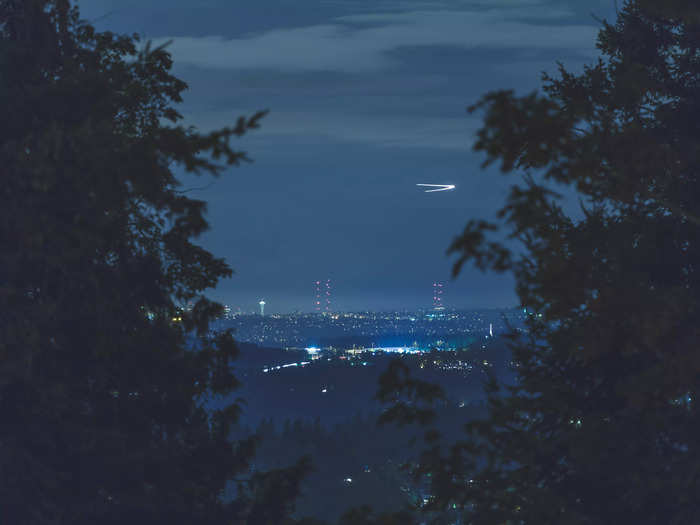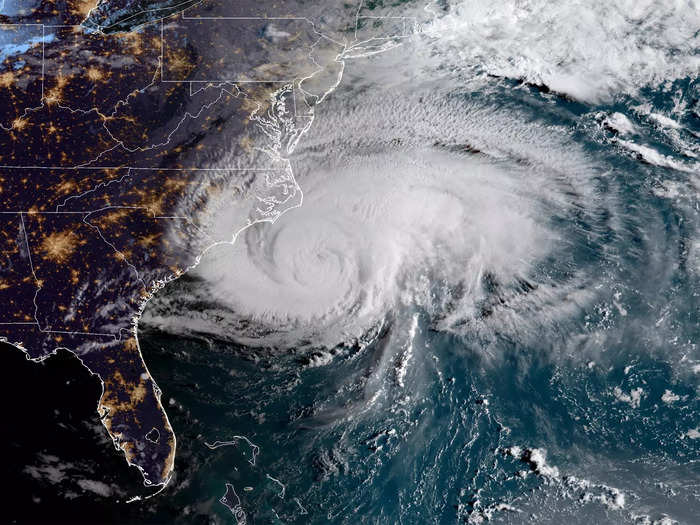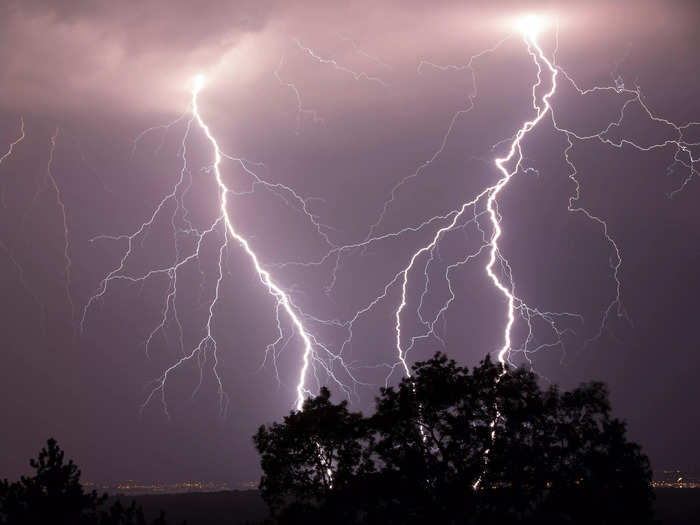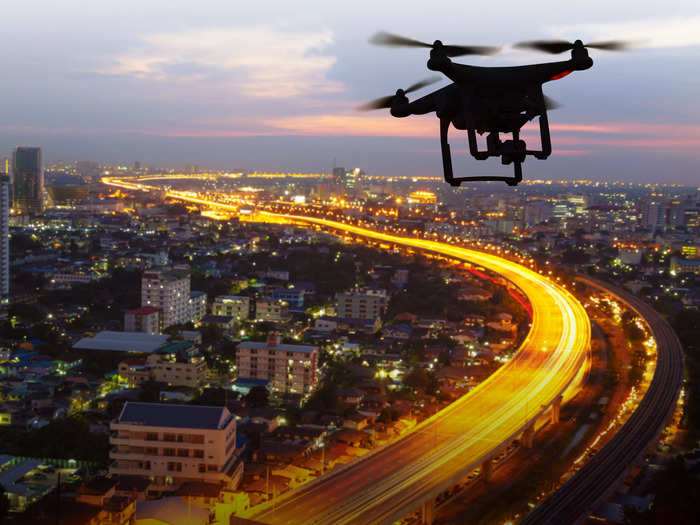10 of the wildest things that pilots have witnessed up in the air
Christina Snyder

- Pilots have a unique viewpoint while flying private or commercial aircraft.
- They get an unobstructed view of stunning natural sights, such as pink lakes and rectangular-shaped icebergs.
Ever wonder what kinds of unusual objects pilots see from the air?
With a truly unique vantage point, they've reported a range of strange sightings, including UFOs, geoglyphs, and drones. But they've also had unobstructed views to some of nature's most incredible sights.
Here are 10 wild things that pilots have seen while flying.
Several pilots have claimed to have seen UFOs.

Pilots have claimed to see UFOs (unidentified flying objects) for decades – sightings usually involve bright lights or objects flying in a formations. In June 1947, for example, pilot Kenneth Arnold said he saw nine glowing blue objects flying in a V over Mount Rainier in Seattle, Washington. In November 2018, pilots reported seeing UFOs off the coast of Ireland.
The US government has studied these unidentified objects over the years, but rather than aliens, these UFOs are thought to be the result of routine military testing, hoaxes, camera errors, and even the planet Venus.
Pilots have flown into and over hurricanes.

National Oceanic and Atmospheric Administration Pilot Terry Lynch recalled his experience of flying near a hurricane to Popular Mechanics.
"I could see the lights of Charleston going out, and I knew they were catching hell down there. I'd much rather be in the air. When the wind pushes, a plane gives," he said of flying over the South Carolina coast during Hurricane Hugo in 1989.
Commercial flights typically go higher in the air than a hurricane, so aircraft can sometimes just fly over them. Meteorologist and pilot James Aydelott told The Points Guy, "Each storm is different, but down low, near the eye, where the C-130 and P-3 'Hurricane Hunter' flights fly, there is often turbulence. High above, from all accounts I've seen, the ride is smooth. As far as flying goes, there should be no issues flying above a hurricane in an aircraft equipped to monitor radar echo tops."
NASA pilots have seen rectangular-shaped icebergs.

NASA pilots spotted a rectangular iceberg while flying over the northern Antarctic Peninsula. Such icebergs look as if they have been purposefully cut, and they are rarely seen. Of the experience, one pilot told Mysterious Universe:
"I thought it was pretty interesting; I often see icebergs with relatively straight edges, but I've not really seen one before with two corners at such right angles like this one had."
Some lucky pilots get to fly over pink lakes as part of their day job.

So many people want to see pink lakes that scenic flights over them are now offered. The most famous is Lake Hillier in Western Australia. There are also pink lakes in British Columbia, Spain, and Canada. The lakes get their pink color from a high level of salinity along with algae that make carotenoids, or organic pigments, turning the water pink. These lakes create such great amounts of salt that locals harvest and use it.
Geoglyphs can also be seen from the sky.

Geoglyphs are designs built into the natural landscape via mounds of earth. Most geoglyphs are large crosses, squares, and rings. Some geoglyphs can be as wide as 1,300 feet. The structural designs can be found in northern Kazakhstan, Russia, Brazil, Peru, and other places.
Pilots have experienced lightning striking their planes.

It's not uncommon for a plane to get hit by lightning. Aircraft are made of aluminum, which conducts electricity, but their design ensures the lightning current stays on the outside of the plane. Some private planes are not made of the same materials as commercial planes, so pilots flying those aircraft need to be cautious about getting near thunderstorms.
NASA pilot Conway Roberts described flying a jet into a cold front to the New York Times:
''I was flying at about 40,000 feet over Amarillo, when I first started seeing lightning from this front several hundred miles away. The thunderstorms that the front was generating were just like a picket fence. They had very little depth and were shoulder-to-shoulder, hundreds of them, and they all had almost continuous lightning.''
St. Elmo's Fire is a phenomenon similar to lightning.

A phenomenon that only some pilots are lucky enough to see, St. Elmo's Fire is similar to lightning.
It's a branch-shaped discharge of atmospheric electricity into the sky that's caused by heavy thunderstorms in combination with a plane flying through an exceptionally high-intensity electric field.
But how exactly does this phenomenon happen? When there is a difference in the concentration of electrons between two objects, the potential difference induces an electric field. This electric field can become so strong that air can no longer suppress it and electrons jump through the air creating a visual spark. This occurrence happens on a lesser scale when you touch a doorknob and give yourself a minor shock. But because thunderstorms create such a powerful electric field, there becomes a dramatic difference in charge between the air and the pointed tip of an airplane, that a continuous spark is created, namely St. Elmo's Fire.
Unlike lightning, St. Elmo's Fire isn't the movement of electricity, but the shot of electrons into the air, aka a "corona discharge."
The flashes in the sky look like dancing lightning bolts. St. Elmo's Fire is usually blue or purple in color, but can also appear to be green. It can also be heard "singing" on the plane's radio — a hissing sound that goes up and down the musical scale.
Some claim they have flown over rainbows.

People have claimed to have flown over rainbows, but the laws of physics tell us that this is not possible. Rainbows are formed when sunlight hits water. The water splits the light into its various colors, reflecting them at an angle of 42 degrees. Since the rainbow is only seen when that consistent angle is maintained, it's impossible to see a rainbow in front of you and then also fly over it. It is possible, however, for a rainbow to appear to the side of or below a plane.
Balloons have appeared at high altitudes.

High-altitude balloons have caused trouble for pilots and airports, since they can obstruct flight sensors and create other problems. A passenger flight over London (flying 10,000 feet over the city) once hit a helium balloon, but it did not have any adverse effects on the flight. However, these high-altitude balloons could potentially cause a collision — they are certainly not something a pilot wants to see at eye level when mid-flight.
Drones have also been getting a little too close to planes, according to pilots.

Pilots have seen drones get very close to their planes. In London earlier this year, a pilot reported spotting a drone flying just 20 feet below the plane. There are strict regulations for drones in flight – they can't come within 50 meters of people or structures or within a kilometer of airports, and can't get higher than 400 feet. The pilot reported the following, which was announced by the UK Airprox Board, according to ITV:
"He had no doubt that it was being deliberately flown under the flight path in an attempt to collide with an aircraft."
Popular Right Now
Popular Keywords
Advertisement